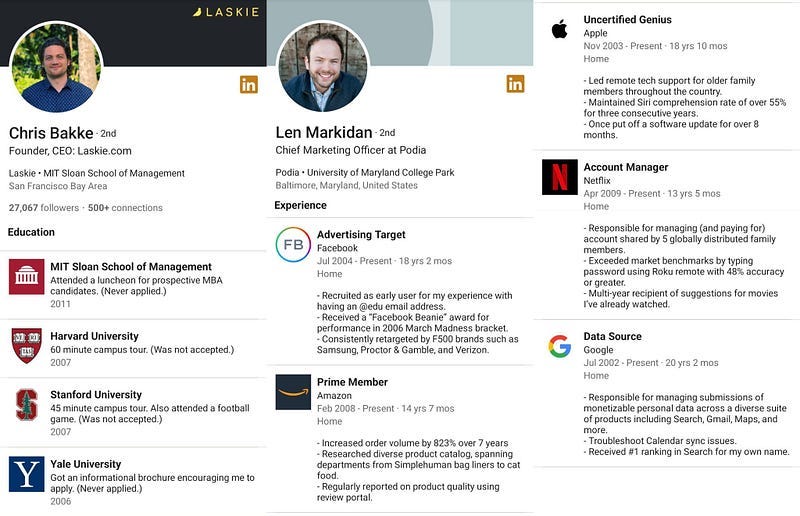15 ways to write your resume — Part 1
Are you a job searcher? Are you tired of submitting resumes and not getting responses? Are you a recruiter? Are you tired of reviewing…
Are you a job searcher? Are you tired of submitting resumes and not getting responses?
Are you a recruiter? Are you tired of reviewing bland, cookie-cutter resumes?
The recent pandemic and the shift to remote work (or at the very least the challenge to the notion that working in an office is the only possibility), created a double-edged phenomenon:
-on the positive side: suddenly, you’re eligible for a lot more positions!
-on the negative side: suddenly, so is everybody else around the world!
The barriers to applying for a job are at their lowest point, which means that your application needs to compete with many (many) others, although the overabundance of applications results in more noise than signal.
In the cacophony of hundreds of applicants per day, it is clear that you need to stand out to be selected. How much out? It’s up to you, your personal brand, what job you’re applying for, at what company, etc.
Yesterday, in between some calls with some mentors and some mentees, I was brainstorming and researching some different approaches and came up with a list of ideas to explore. It was fun and I could keep going for hours, but decided to stop at 15 and break it into three posts because otherwise, I would never write the article, but I would be interested in hearing what my readers could add to the list. Here’s my (mostly lighthearted but with some nuggets of wisdom!) list — part 1:
1- The PM style: your CV as a Product
Approach your resume as a product that solves the problem of finding you a job interview (not a job, because for that you would need to pass the interviews and that…is a whole other issue). You could:
-create a business model canvas for yourself to understand your viability as a candidate
-utilize frameworks (e.g. MoSCoW) to prioritize and roadmap your job search efforts, tracking activities on some of the usual trade tools or with some job search specialized ones.
-A/B test different variants of your resume, track the findings, and use them to lead your search.
-define some metrics for your search and optimize for them
-create hypotheses and test them with experiments (does reaching out to recruiters increase the likelihood of being contacted? What about publishing content on social media? etc.). A word of caution: “Florida man” are definitely 2 words you’re not likely to see in the title of any academic research paper.
-reverse the angle: we said your resume solves the problem of finding you an interview…but another way to see it is that you’re solving the recruiter’s problem of finding a candidate to interview so you could conduct user research by talking to some recruiters to understand what are their pain points.
2- The Influencer style: go crazy, go viral!
Your PDF resume is so early 2021…
Did you know that since July 2021 you can create a TikTok resume?
OK, OK, I know what you are probably asking:

Fully flexing your social media skills can be useful for some positions at some companies. LinkedIn is not the only website recruiters use. Viralize yourself, but be careful not to turn into a meme.

3- The storyteller style: write your own story
Enough is being written about storytelling in resumes and narrative resumes. But what if you kicked it up a notch and wrote a short story with you as a character that you shared with the recruiter?
Kind of like: “Once upon a time, there was this kid that dreamt of building LEGO projects…and now he’s here knocking at your door resume-in-hand, Mr. LEGO Recruiter. “ but better. Or maybe a comic book, or a short video, movie trailer style (“In a world…”).
Maybe, if prose is not your format, you could try a haiku:
“Well versed in Java,
microservices galore,
waiting your call now.”
Or a limerick
“There was once a Scrum Master named Tim
Who could draw burndown charts in his dreams
Knew all topics agile
Out of job for a while
Could start working tomorrow, it seems.”
Or a decima (sorry, this one works better in Spanish)
“Por diez años lideré equipos
ágiles de alto desempeño,
cumpliendo millares de sueños
de clientes, y mil prototipos
entregamos con gran anticipo.
Con las métricas bien en norma,
presupuesto, en tiempo y forma.
No hubo sprints con demora,
ni posts de última hora
que opacaran la plataforma.”
(Some of the verses might be slightly off, but you get the idea…)
4- The data savvy style: facts, not opinions
One of the most frequent tips you read about resumes is to make it about results achieved in each position.
But what if you could make it ALL about results achieved?
You could transform your resume into a dashboard and showcase your mad Tableau skills at the same time.
5- The trophy collector style: a museum of you
You like to learn. You enjoy collecting certificates and ribbons and adding all these acronyms at the end of your name. Why not show them off as if it was an exhibition of your biggest career accomplishments?
For some positions, credentials are very important and it would make sense to highlight them as much as possible.
Use with caution, though: no IT recruiter is interested in the second prize you got in pottery, or your “Biggest biceps Award in Grade 8”. That’s just a weird flex.
And be mindful of credential inflation:

Enjoying the list so far? Finding some worthwhile ideas to explore?
Follow me for more ideas on resume styles in Part 2.


